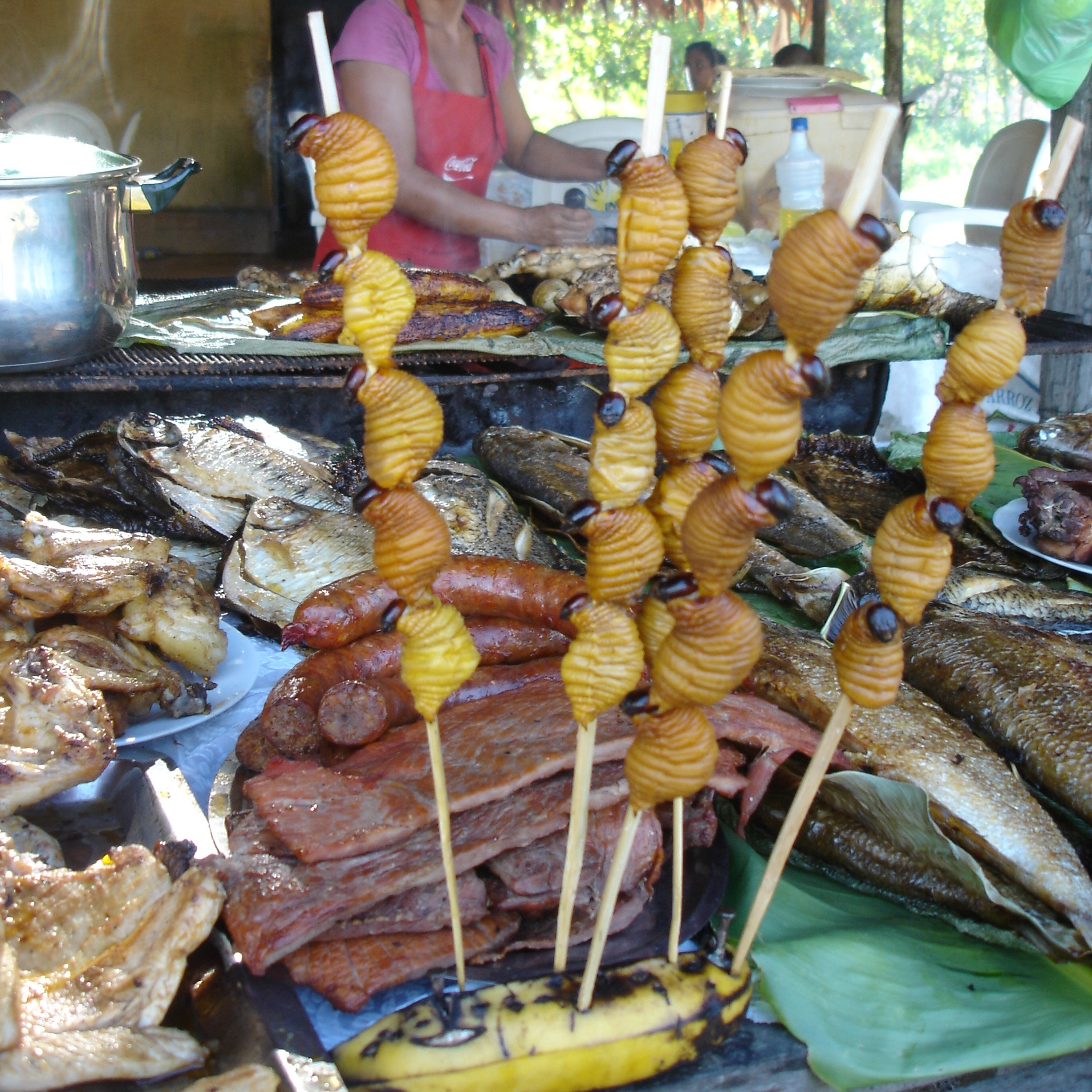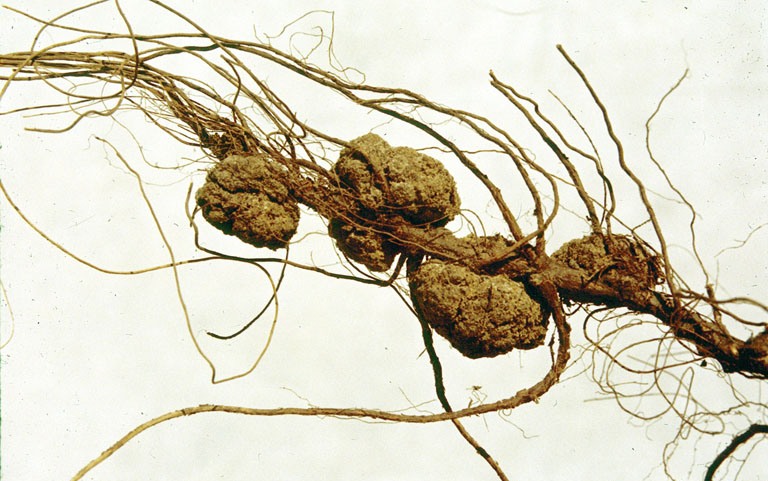|
Red Ring Disease
The red ring disease of coconuts and African oil palms is caused by the nematode ''Bursaphelenchus cocophilus''. It is also identified in literature with an alternative scientific name ''Rhadinaphelenchus cocophilus''. The common name, red ring nematode, is derived from its distinguishing symptom. Significance This nematode can cause losses up to 80% in ''Elaeis guineensis'' (oilpalm) plantations, however, the losses typically range from 10 to 15% on coconut palms and oil palms. The most economically severe losses are in coconut, oilpalm, and dates.p.315, "''Bursaphelenchus cocophilus'' (red ring nematode) is vectored by ''Rhynchophorus palmarum'' weevils and causes red ring disease in several palm species in the Caribbean and Latin America."p.322, "The most economically important species attacked by ''B. cocophilus'' are coconut palm, the African oil palm, and the date palm." It and '' B. xylophilus'' are the only two economically significant diseases in ''Bursaphelenchus''.p.32 ... [...More Info...] [...Related Items...] OR: [Wikipedia] [Google] [Baidu] |
Annual Review Of Phytopathology
The ''Annual Review of Phytopathology'' is a peer-reviewed academic journal that publishes review articles about phytopathology, the study of diseases that affect plants. It was first published in 1963 as the result of a collaboration between the American Phytopathological Society and the nonprofit publisher Annual Reviews. As of 2024, ''Journal Citation Reports'' lists the journal's 2023 impact factor as 9.1, ranking it tenth of 265 journal titles in the category "Plant Sciences". As of 2023, it is being published as open access, under the Subscribe to Open model. Its current editors are John M. McDowell and Gwyn A. Beattie. History In the 1950s, the American Phytopathological Society had intended to publish its own journal to cover significant developments in the field of phytopathology, or plant diseases. However, the nonprofit publisher Annual Reviews offered to publish the journal for them, and they agreed due to their publishing experience. In 1961, the American Phyt ... [...More Info...] [...Related Items...] OR: [Wikipedia] [Google] [Baidu] |
Palmae
The Arecaceae () is a family of perennial, flowering plants in the monocot order Arecales. Their growth form can be climbers, shrubs, tree-like and stemless plants, all commonly known as palms. Those having a tree-like form are colloquially called palm trees. Currently, 181 genera with around 2,600 species are known, most of which are restricted to tropical and subtropical climates. Most palms are distinguished by their large, compound, evergreen leaves, known as fronds, arranged at the top of an unbranched stem, except for the Hyphaene genus, who has branched palms. However, palms exhibit an enormous diversity in physical characteristics and inhabit nearly every type of habitat within their range, from rainforests to deserts. Palms are among the best known and most extensively cultivated plant families. They have been important to humans throughout much of history, especially in regions like the Middle East and North Africa. A wide range of common products and foods are de ... [...More Info...] [...Related Items...] OR: [Wikipedia] [Google] [Baidu] |
Tree Diseases
Plant diseases are diseases in plants caused by pathogens (infectious organisms) and environmental conditions (physiological factors). Organisms that cause infectious disease include fungus, fungi, oomycetes, bacterium, bacteria, plant virus, viruses, viroids, virus-like organisms, phytoplasmas, protozoa, nematodes and parasitic plants. Not included are ectoparasites like insects, mites, vertebrates, or other Plant defense against herbivory, pests that affect plant health by eating plant tissues and causing injury that may admit plant pathogens. The study of plant disease is called plant pathology. Plant pathogens Fungi Most phytopathogenic fungi are Ascomycota, Ascomycetes or Basidiomycota, Basidiomycetes. They reproduce both sexual reproduction, sexually and asexual reproduction, asexually via the production of spores and other structures. Spores may be spread long distances by air or water, or they may be soil borne. Many soil inhabiting fungi are capable of living sap ... [...More Info...] [...Related Items...] OR: [Wikipedia] [Google] [Baidu] |
Aphelenchida
Aphelenchida is a moderately large order of nematodes. Aphelenchida have a stylet for feeding and a very prominent median bulb in the oesophagus. They are cosmopolitan. Some are associated with insects, and may be ectoparasites or endoparasites, or merely use the insect as transport. Others are associated with plants, as root, stem, or leaf parasites, which may be pathogenic to the plant or not. Still others are associated with fungi A fungus (: fungi , , , or ; or funguses) is any member of the group of eukaryotic organisms that includes microorganisms such as yeasts and mold (fungus), molds, as well as the more familiar mushrooms. These organisms are classified as one ..., and some are free-living. There may be considerable plasticity of feeding habits within species, involving almost any combination of the categories listed above. Sometimes different feeding habits involve morphologically distinct phases, but they may involve only behavioral differences, and sometimes ... [...More Info...] [...Related Items...] OR: [Wikipedia] [Google] [Baidu] |
University Of Florida
The University of Florida (Florida or UF) is a public university, public land-grant university, land-grant research university in Gainesville, Florida, United States. It is a senior member of the State University System of Florida and a preeminent university in the state. The university traces its origins to 1853 and has operated continuously on its Gainesville campus since September 1906. After the Florida state legislature's creation of performance standards in 2013, the Florida Board of Governors designated the University of Florida as a "preeminent university". The University of Florida is one of three members of the Association of American Universities in Florida and is Carnegie Classification of Institutions of Higher Education, classified among "R1: Doctoral Universities – Very high research spending and doctorate production". The university is Higher education accreditation in the United States, accredited by the Southern Association of Colleges and Schools (SACS). ... [...More Info...] [...Related Items...] OR: [Wikipedia] [Google] [Baidu] |
Chlorosis
In botany, chlorosis is a condition in which leaves produce insufficient chlorophyll. As chlorophyll is responsible for the green color of leaves, chlorotic leaves are pale, yellow, or yellow-white. The affected plant has little or no ability to manufacture carbohydrates through photosynthesis and may die unless the cause of its chlorophyll insufficiency is treated and this may lead to a plant disease called rusts, although some chlorotic plants, such as the albino ''Arabidopsis thaliana'' mutant ''ppi2'', are viable if supplied with exogenous sucrose. The word ''chlorosis'' is derived from the Greek ''khloros'' meaning "greenish-yellow", "pale green", "pale", "pallid", or "fresh". In viticulture, the most common symptom of poor nutrition in grapevines is the yellowing of grape leaves caused by chlorosis and the subsequent loss of chlorophyll. This is often seen in vineyard soils that are high in limestone such as the Italian wine region of Barolo in the Piedmont (wine), Piedmont ... [...More Info...] [...Related Items...] OR: [Wikipedia] [Google] [Baidu] |
Rhynchophorus Palmarum
The South American palm weevil, ''Rhynchophorus palmarum'', is a species of snout beetle. The adults are relatively large black beetles of approximately one and a half inch in length, and the larvae may grow to two inches in length. Biology and behavior These insects are attracted to the release of volatile compounds produced by injured palm trees. The larvae burrow through the hearts of palms, and their feeding can potentially kill an infested palm or serve as an avenue for secondary infections of bacterial disease. It is considered an important pest of cultivated coconut, date and oil palms, attacking thirty-five different species in twelve different families.Griffith, R. 1987"Red ring disease of coconut palm" ''Plant Disease'' 71: 193–196.Sanchez, P and H. Cerda. 1993.El complejo ''Rhynchophorus palmarum'' (L) (Coleoptera: Curculionidae) - ''Bursaphelenchus cocophilus'' (Cobb) (Tylenchida: Aphelenchoididae), en Palmeras.. ''Boletín di Entomología Venezolana'' 8, 1–18 ... [...More Info...] [...Related Items...] OR: [Wikipedia] [Google] [Baidu] |
Dauer Larva
Dauer ( German "", English "the endurance", "persistence"; "unlimited time" ) describes an alternative developmental stage of nematode worms, particularly rhabditids including ''Caenorhabditis elegans'', whereby the larva goes into a type of stasis and can survive harsh conditions. Since the entrance of the dauer stage is dependent on environmental cues, it represents a classic and well studied example of polyphenism. The dauer state is given other names in the various types of nematodes such as ‘ diapause’ or ‘hypobiosis’, but since the ''C. elegans'' nematode has become the most studied nematode, the term ‘dauer stage’ or 'dauer larvae' is becoming universally recognised when referring to this state in other free-living nematodes. The dauer stage is also considered to be equivalent to the infective stage of parasitic nematode larvae. As Émile Maupas first proposed in 1899 and 1900, all nematodes have five stages separated by four moults. Under environmental condit ... [...More Info...] [...Related Items...] OR: [Wikipedia] [Google] [Baidu] |
Nematode Plant Disease
Plant diseases are diseases in plants caused by pathogens (infectious organisms) and environmental conditions (physiological factors). Organisms that cause infectious disease include fungi, oomycetes, bacteria, viruses, viroids, virus-like organisms, phytoplasmas, protozoa, nematodes and parasitic plants. Not included are ectoparasites like insects, mites, vertebrates, or other pests that affect plant health by eating plant tissues and causing injury that may admit plant pathogens. The study of plant disease is called plant pathology. Plant pathogens Fungi Most phytopathogenic fungi are Ascomycetes or Basidiomycetes. They reproduce both sexually and asexually via the production of spores and other structures. Spores may be spread long distances by air or water, or they may be soil borne. Many soil inhabiting fungi are capable of living saprotrophically, carrying out the role of their life cycle in the soil. These are facultative saprotrophs. Fungal diseases may be con ... [...More Info...] [...Related Items...] OR: [Wikipedia] [Google] [Baidu] |
Annual Reviews (publisher)
Annual Reviews is an independent, non-profit academic publishing company based in San Mateo, California. As of 2021, it publishes 51 journals of review articles and ''Knowable Magazine'', covering the fields of List of life sciences, life, Biomedical sciences, biomedical, Outline of physical science, physical, and Social science, social sciences. Review articles are usually "peer-invited" solicited submissions, often planned one to two years in advance, which go through a peer-review process. The organizational structure has three levels: a volunteer board of directors, editorial committees of experts for each journal, and paid employees. Annual Reviews' stated Mission statement, mission is to synthesize and integrate knowledge "for the progress of science and the benefit of society". The first Annual Reviews journal, the ''Annual Review of Biochemistry'', was published in 1932 under the editorship of Stanford University chemist J. Murray Luck, who wanted to create a resource ... [...More Info...] [...Related Items...] OR: [Wikipedia] [Google] [Baidu] |
Biosecurity Inspection
Biosecurity refers to measures aimed at preventing the introduction or spread of harmful organisms (e.g. viruses, bacteria, plants, animals etc.) intentionally or unintentionally outside their native range or within new environments. In agriculture, these measures are aimed at protecting food crops and livestock from pests, invasive species, and other organisms not conducive to the welfare of the human population. The term includes biological threats to people, including those from pandemic diseases and bioterrorism. The definition has sometimes been broadened to embrace other concepts, and it is used for different purposes in different contexts. The COVID-19 pandemic is a recent example of a threat for which biosecurity measures have been needed in all countries of the world. Background and terminology The term "biosecurity" has been defined differently by various disciplines. The term was first used by the agricultural and environmental communities to describe preventative me ... [...More Info...] [...Related Items...] OR: [Wikipedia] [Google] [Baidu] |
Sanitary And Phytosanitary Measures And Agreements
Sanitation refers to public health conditions related to clean drinking water and treatment and disposal of Human waste, human excreta and sewage. Risk management, Preventing human contact with feces is part of sanitation, as is hand washing with soap. Sanitation systems aim to protect human health by providing a clean environment that will stop the Transmission (medicine), transmission of disease, especially through the fecal–oral route.SuSanA (2008)Towards more sustainable sanitation solutions . Sustainable Sanitation Alliance (SuSanA) For example, diarrhea, a main cause of Undernutrition in children, malnutrition and stunted growth in children, can be reduced through adequate sanitation. There are many other diseases which are easily transmitted in communities that have low levels of sanitation, such as ascariasis (a type of intestinal worm infection or helminthiasis), cholera, hepatitis, polio, schistosomiasis, and trachoma, to name just a few. A range of sanitation techno ... [...More Info...] [...Related Items...] OR: [Wikipedia] [Google] [Baidu] |






